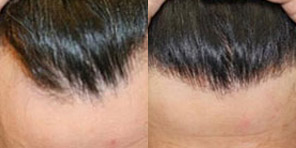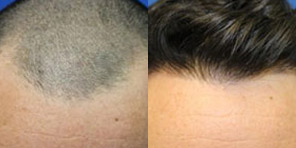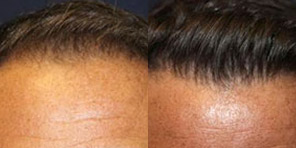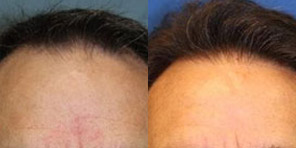Androgenic alopecia is the most common cause of hair loss in both men and women. It’s estimated that about 40% of men notice baldness by the age of 40. This percentage increases with increasing age. Patterns of hair loss are often somewhat different between the sexes. Men usually begin to notice baldness along the frontal hairline which recedes with advancing age and deepens along the temporal region. The hairline becomes narrower and higher with time. Hair loss may be localized to just the frontal region or also involve the crown or top of the head. In women, hair loss may either be diffuse causing generalized alopecia or more localized to the frontal region as in men.
In androgenic alopecia, hair loss does not involve the occipital area, the region along the back of the head between the ears. The hair follicles in this area are resistant to hair loss and remain the primary source of grafts used in hair transplant surgery.
Contents
Causes of Hair Loss
While androgenic alopecia causes most cases of hair loss, it is also important to understand that hair loss may have many other causes. There are numerous medicines which cause hair loss as a side effect. Some of them include medicines to treat gout, depression, hypertension, and hormonal imbalance.
Medical illnesses causing hair loss include thyroid disease, anemia, protein deficiency, and vitamin deficiencies. Chemotherapy may cause a temporary or even permanent loss of hair. Hair loss may also result from underlying stress associated with a chronic illness, fever, or surgical trauma but is usually temporary in duration.
Underlying skin conditions which affect the scalp will often result in alopecia including alopecia areata,scarring alopecia, and traction alopecia. These conditions are best treated by a dermatologist and can result in correction of baldness.
Hair Restoration Options
Patients who are ideal candidates for hair restoration surgery usually have androgenic alopecia and are otherwise in good health. The areas of hair loss should be limited to the frontal and crown region. The donor area should also be relatively dense with little to no previous scars from prior hair restoration procedures. Women may also be good surgical candidates if the area of alopecia is localized versus diffuse and resembles the pattern of loss in men.
Patients considering hair restoration surgery must have realistic expectations as for any elective cosmetic (aesthetic) procedure. We lose nearly 50% of our hair before noticing baldness. Hair restoration surgery may create or restore a frontal hairline and add density to the crown area but will not usually return a patient’s hairline to the density and shape it once had as a teenager. This is simply due to the limited supply of donor follicles which are available along the back of the head. However, most patients who are good candidates for hair transplantation procedures are very pleased with the final results which appear natural with today’s technology.
Hair restoration technology has improved drastically since its inception in the 1960’s. Early hair restoration involved excising a large portion of the scalp with its hair follicles from the back of the head with a scalpel and electrocautery.
This was called the FUT (follicular unit transplant) method which involved excising a strip of scalp was divided into smaller and smaller transplant units which were ultimately transplanted into balding areas of the scalp in the frontal and crown region. The defect created in the back of the head was closed with sutures or staples, often under tension. This often resulted in a wide scar with surrounding hair loss and permanent numbness to the scalp. Patients often complained of significant pain and swelling during the recovery process which could take several weeks.
Modern Hair Restoration Techniques
Current techniques involve the use of the FUE (follicular unit extraction) method using advanced semi-automatic devices which extract the hair follicles as individual units using a small punch often less than one millimeter in diameter. The procedure is much less invasive than the older FUT method and avoids the need for sutures. The scalp heals and no linear scar is created in the back of the head. Hair loss is minimized because there is no tension on the scalp. Patients do not experience significant discomfort, prolonged swelling, nor permanent scalp numbness as this procedure is much less invasive. There is also minimal manipulation of the hair follicles so graft survival is maximized.
The three most common devices which are used for this procedure are the Neograft, Smart Graft, and Artas (robot). The Neograft device has been in use for the longest time period of these three devices. Results appear similar regardless of which device is employed and are more dependent upon the experience of the team versus the device.
The Hair Restoration Process
Hair restoration is generally performed in an office setting under local anesthesia with oral sedation in some cases. If the frontal hairline is to undergo hair transplantation, great care is taken to design this hairline in a natural and age appropriate manner.
It is often helpful for patients to bring photos of their faces from earlier years to evaluate the shape and position of their hairline so that the final result is completely natural and indetectable.
The hair along the back of the head is shaved down with hair clippers and local anesthesia is injected into the scalp. The FUE device is employed to harvest the hair follicles which are stored prior to transplantation. After the grafts have been harvested, local anesthesia is applied to the balding scalp where the grafts will be implanted. Small slits will be made in the scalp with either a needle or scalpel in preparation for placement of hair follicles. The hair follicles are individually placed in the scalp by hand with small forceps. The use of a needle or scalpel to create these recipient sites for placement of hair grafts avoids any noticeable scars.
Post-Operative Care
At the end of the hair restoration procedure, a light dressing is applied overnight, and the patient is seen the following day in the office to remove it and inspect the scalp and grafts. No other dressing is usually needed. There is usually minimal discomfort and swelling of the scalp following FUE hair restoration and most patients will take oral pain medication for a few days after the procedure. Most patients take off one week from work. They can return to light physical exercise within two weeks and all physical activities within a month. There are often small crusts at the base of the hair transplants which will fall off within seven to ten days after the procedure.
The small hairs associated with each hair graft will usually fall out within a few weeks following transplantation and begin to grow at about 3 months. The final results will be seen within 12-18 months after the procedure. Patients who are candidates for further hair restoration to increase density should wait at least 1 to ½ years following the initial procedure to avoid damage to existing hair follicles. It is also recommended that most hair transplant patients begin on maintenance therapy of Rogaine and Finasteride as studies indicate 70-80% of patients will stabilize their hair loss if these medications are continued on a daily basis.
Hair loss patients who are suitable candidates for hair restoration are generally very pleased with the aesthetic outcome of this procedure. Unlike some other aesthetic procedures, the results of successful hair transplantation are permanent as the transplanted hair follicles will continue to grow throughout the patient’s lifetime. The results should appear very natural and not detectable to others.
Hair Restoration Procedure Pricing
The cost of hair restoration procedures depends upon the experience and skill of the practice. Practices which devote significant time and resources to hair restoration usually have the greatest volume of cases and the most experience. In general, hair restoration costs are based upon the number of grafts needed for each particular patient. Costs vary from $6000 for small cases, $10,000 for medium sized cases, and $12,000 – $15,000 for large cases. Small cases are generally 1000 grafts or less, medium cases are 1500 grafts, and large cases are 2000 grafts or more.
Looking for the Right Hair Restoration Expert?
Plastic surgeons are ideally suited to perform hair restoration. Plastic surgery training involves at least 6 years of surgical training after medical school which includes surgery of the scalp and hair in both complex reconstructive and elective cosmetic procedures. Plastic surgeons develop microsurgical skills during their training which are assets that transfer to hair restoration. Plastic surgeons develop special expertise in the art and science of aesthetics which are vital to creating a youthful yet natural hairline. Plastic surgeons have always been at the forefront of technology and innovation in all areas of aesthetic plastic surgery which includes hair restoration. Many of the semi-automatic FUE devices like Neograft are used by board certified plastic surgeons across the country.
If you are contemplating hair restoration then consider a board certified plastic surgeon who also performs hair restoration procedures. Visit the doctor’s website to view before and after photos. Consider a consultation with the plastic surgeon to see if you are a suitable candidate for hair restoration. Visit https://californiahairmd.com/ to find out more information about hair loss and to find a board certified plastic surgeon in your community.






